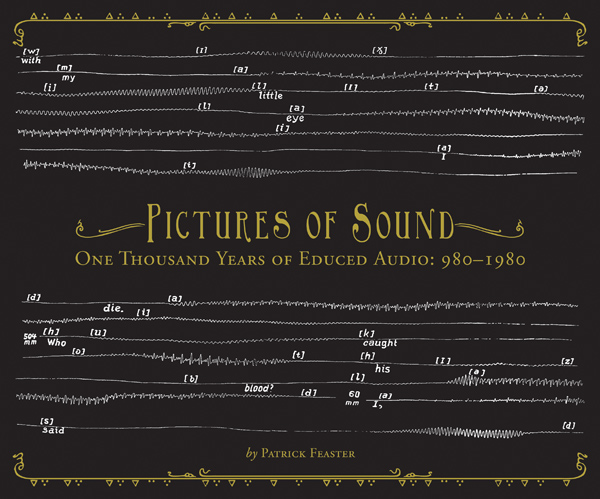Patrick Feaster: Pictures of Sound: One Thousand Years of Educed Audio, 980-1980 + CD (2012)
Filed under book, sound recording | Tags: · history of technology, media archeology, phonograph, sound, sound recording, technology

“Using modern technology, Patrick Feaster is on a mission to resurrect long-vanished voices and sounds—many of which were never intended to be revived.
Over the past thousand years, countless images have been created to depict sound in forms that theoretically could be “played” just as though they were modern sound recordings. Now, for the first time in history, this compilation uses innovative digital techniques to convert historic “pictures of sound” dating back as far as the Middle Ages directly into meaningful audio. It contains the world’s oldest known “sound recordings” in the sense of sound vibrations automatically recorded out of the air—the groundbreaking phonautograms recorded in Paris by Édouard-Léon Scott de Martinville in the 1850s and 1860s—as well as the oldest gramophone records available anywhere for listening today, including inventor Emile Berliner’s recitation of Der Handschuh, played back from an illustration in a magazine, which international news media recently proclaimed to be the oldest audible “record” in the tradition of 78s and vintage vinyl. Other highlights include the oldest known recording of identifiable words spoken in the English language (1878) and the world’s oldest surviving “trick recording” (1889). But Pictures of Sound pursues the thread even further into the past than that by “playing” everything from medieval music manuscripts to historic telegrams, and from seventeenth-century barrel organ programs to eighteenth-century “notations” of Shakespearean recitation.
In short, this isn’t just another collection of historical audio—it redefines what “historical audio” is.”
Publisher Dust-to-Digital, Atlanta/GA, 2012
144 pages, with 164 images
via prohairesis
Review: Randall Roberts (LA Times).
FirstSounds.org initiative
Patrick Feaster discusses Pictures of Sound (video, 36 min)
Author
Publisher
PDF, PDF (29 MB, updated on 2018-3-29)
ZIP (CD, 92 MB, ZIP’d OGG, updated on 2016-12-23)
Sensate: A Journal for Experiments in Critical Media Practice (2012-)
Filed under journal | Tags: · archive, art, digital humanities, ethnography, film, history of technology, media archeology, media art, photography, sensory ethnography, sociology, sound, video, visual anthropology

Sensate is a peer-reviewed, issueless, open-access, media-based journal for the creation, presentation, and critique of innovative projects in the arts, humanities, and sciences. Its mission is to provide a scholarly and artistic forum for experiments in critical media practices that expand academic discourse by taking us beyond the margins of the printed page. Fundamental to this expansion is a re-imagining of what constitutes a work of scholarship or art.
Editors-in-Chief: Lindsey Lodhie, Peter McMurray, Joana Pimenta, and Elizabeth Watkins
Creative Commons 3.0 Attribution license
Friedrich A. Kittler: Gramophone, Film, Typewriter (1986–) [DE, EN]
Filed under book | Tags: · film, history of technology, literary theory, literature, media, media archeology, media theory, poetry, psychoanalysis, sound, sound recording, technology, typewriter, writing

“Toward the end of the nineteenth century, the hegemony of the printed word was shattered by the arrival of new media technologies that offered novel ways of communicating and storing data. Previously, writing had operated by way of symbolic mediation—all data had to pass through the needle’s eye of the written signifier—but phonography, photography, and cinematography stored physical effects of the real in the shape of sound waves and light. The entire question of referentiality had to be recast in light of these new media technologies; in addition, the use of the typewriter changed the perception of writing from that of a unique expression of a literate individual to that of a sequence of naked material signifiers.
Part technological history of the emergent new media in the late nineteenth century, part theoretical discussion of the responses to these media—including texts by Rilke, Kafka, and Heidegger, as well as elaborations by Edison, Bell, Turing, and other innovators—Gramophone, Film, Typewriter analyzes this momentous shift using insights from the work of Foucault, Lacan, and McLuhan. Fusing discourse analysis, structuralist psychoanalysis, and media theory, the author adds a vital historical dimension to the current debates over the relationship between electronic literacy and poststructuralism, and the extent to which we are constituted by our technologies. The book ties the establishment of new discursive practices to the introduction of new media technologies, and it shows how both determine the ways in which psychoanalysis conceives of the psychic apparatus in terms of information machines.
Gramophone, Film, Typewriter is, among other things, a continuation as well as a detailed elaboration of the second part of the author’s Discourse Networks, 1800/1900 (Stanford, 1990). As such, it bridges the gap between Kittler’s discourse analysis of the 1980’s and his increasingly computer-oriented work of the 1990’s.”
Publisher Brinkmann & Bose, Berlin, 1986
ISBN 3922660177
427 pages
English edition
Translated, with an Introduction by Geoffrey Winthrop-Young and Michael Wutz
Publisher Stanford University Press, 1999
ISBN 0804732337, 9780804732338
315 pages
Reviews: Bruce Clarke (Electronic Book Review, 1999), Alex Magoun (Technology and Culture, 2001).
Grammophon Film Typewriter (German, 1986, 7 MB, added on 2014-6-30, updated on 2019-5-2)
Gramophone, Film, Typewriter (English, trans. Geoffrey Winthrop-Young and Michael Wutz, 1999, updated on 2012-10-13)

